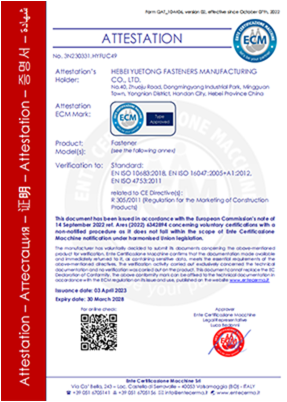Sep . 24, 2024 19:28 Back to list
imperial bolt sizes in mm
Understanding Imperial Bolt Sizes in Metric A Comprehensive Guide
When it comes to fastening in mechanical design, the choice of bolts is critical. Engineers and DIY enthusiasts often encounter both metric and imperial measurements, which can lead to confusion, especially when dealing with imperial bolt sizes. Understanding how to convert these sizes into millimeters is essential for ensuring compatibility and functionality in various applications.
Imperial Bolt Sizes The Basics
Imperial bolt sizes are typically measured in inches. For example, common sizes include 1/4, 3/8, 1/2, and so on. These measurements refer to the nominal diameter of the bolt. However, when working on projects that require precision, such as automotive repairs or machinery assembly, it is often necessary to convert these imperial measurements to metric equivalents, commonly used in many countries around the world.
Conversion from Imperial to Metric
The conversion from inches to millimeters can be achieved using a simple conversion factor 1 inch is equal to 25.4 millimeters. Therefore, to convert imperial bolt sizes to millimeters, you can multiply the size in inches by 25.4. For example
- A 1/4 bolt is approximately 6.35 mm (0.25 inches × 25.4 mm/inch). - A 3/8 bolt is approximately 9.53 mm (0.375 inches × 25.4 mm/inch). - A 1/2 bolt is approximately 12.7 mm (0.5 inches × 25.4 mm/inch).
Understanding these conversions allows for a smoother integration of imperial bolts into metric systems
.imperial bolt sizes in mm

Common Imperial Bolt Sizes and Their Metric Equivalents
Here is a table for reference, displaying some common imperial bolt sizes along with their metric equivalents
| Imperial Size | Metric Size (mm) | |---------------|------------------| | 1/4 | 6.35 mm | | 5/16 | 7.94 mm | | 3/8 | 9.53 mm | | 7/16 | 11.11 mm | | 1/2 | 12.7 mm | | 5/8 | 15.88 mm | | 3/4 | 19.05 mm | | 7/8 | 22.23 mm | | 1 | 25.4 mm |
Considerations When Using Imperial Bolts
While converting imperial bolt sizes into metric can provide a solution, it is essential to consider other factors such as thread pitch and strength. For instance, imperial bolts often have different thread pitches compared to their metric counterparts. Therefore, ensuring that the threads are compatible is crucial for maintaining the integrity of the assembly.
Additionally, the strength of bolts can vary based on their grade. Common grades for imperial bolts include Grade 2, Grade 5, and Grade 8, each with differing tensile strengths. When substituting imperial bolts with metric ones, it is vital to choose bolts of equivalent strength to avoid compromising the structure's integrity.
Conclusion
Understanding imperial bolt sizes and their conversion to metric measurement is invaluable for anyone involved in mechanical design or assembly. By grasping the conversion process and recognizing the importance of thread compatibility and strength, engineers and hobbyists alike can make informed choices. This knowledge not only facilitates smooth project execution but also enhances safety and functionality in various applications. Whether working on a simple DIY project or a complex mechanical assembly, being equipped with the right information on bolt sizes is a critical component of success.


